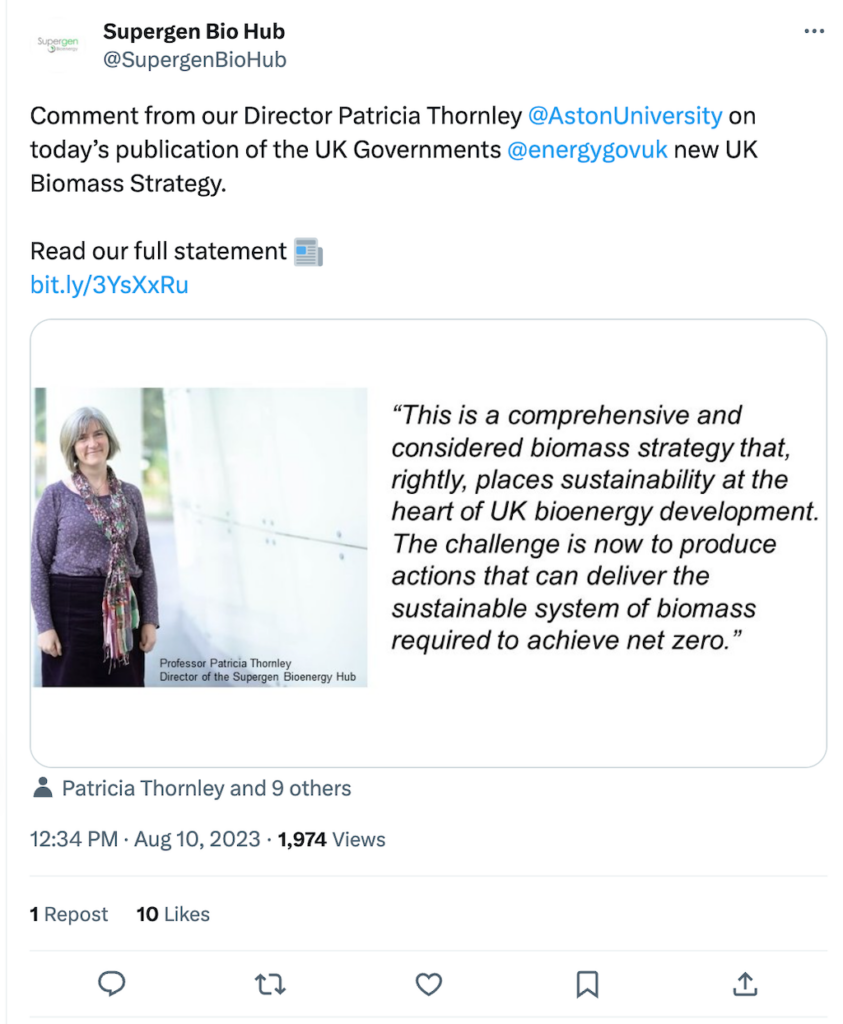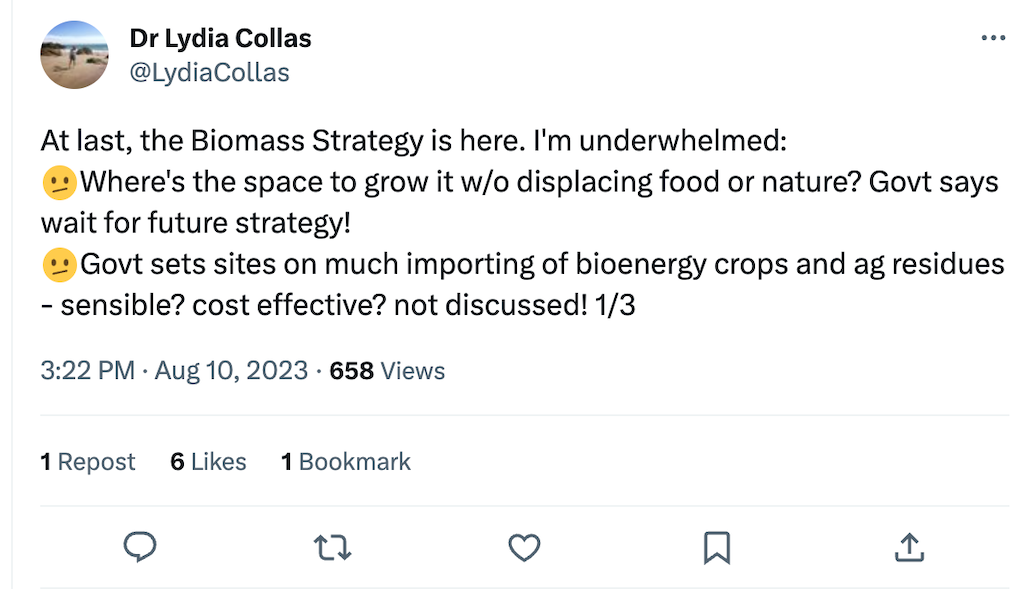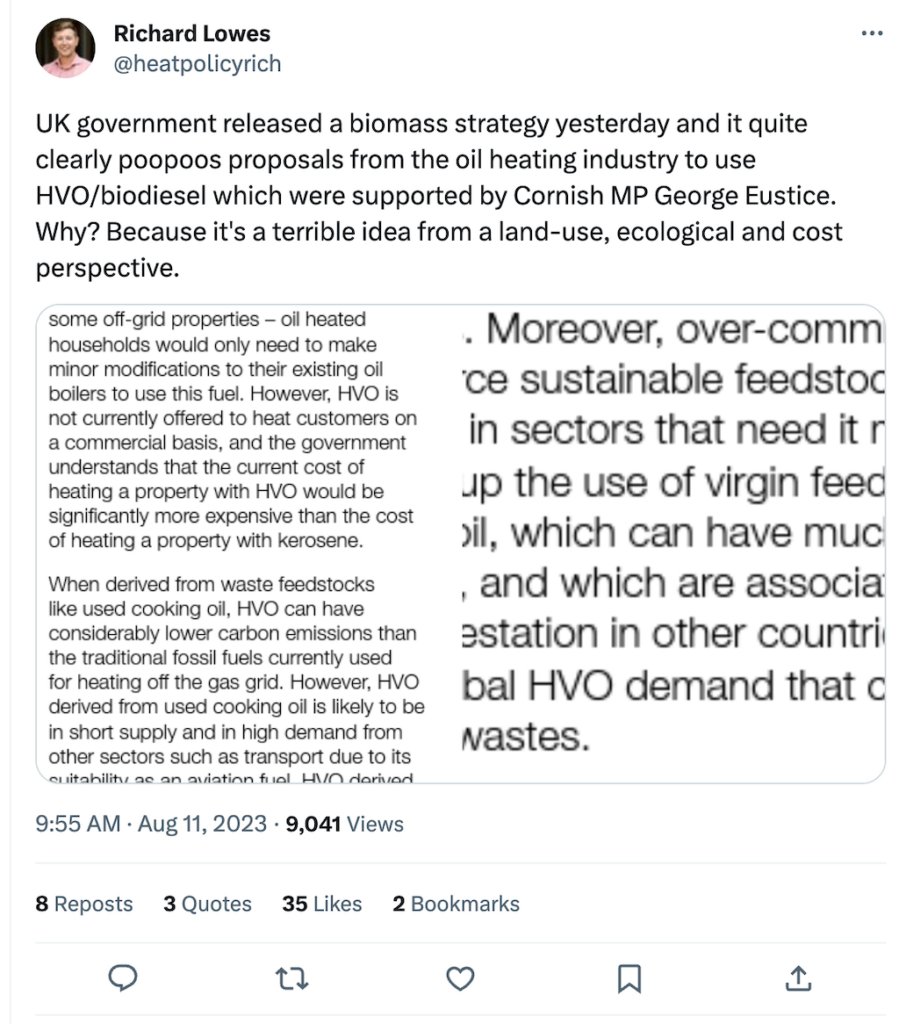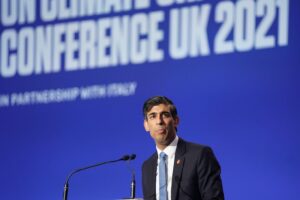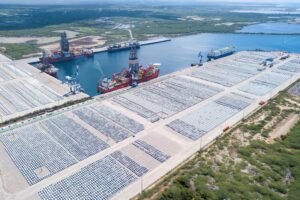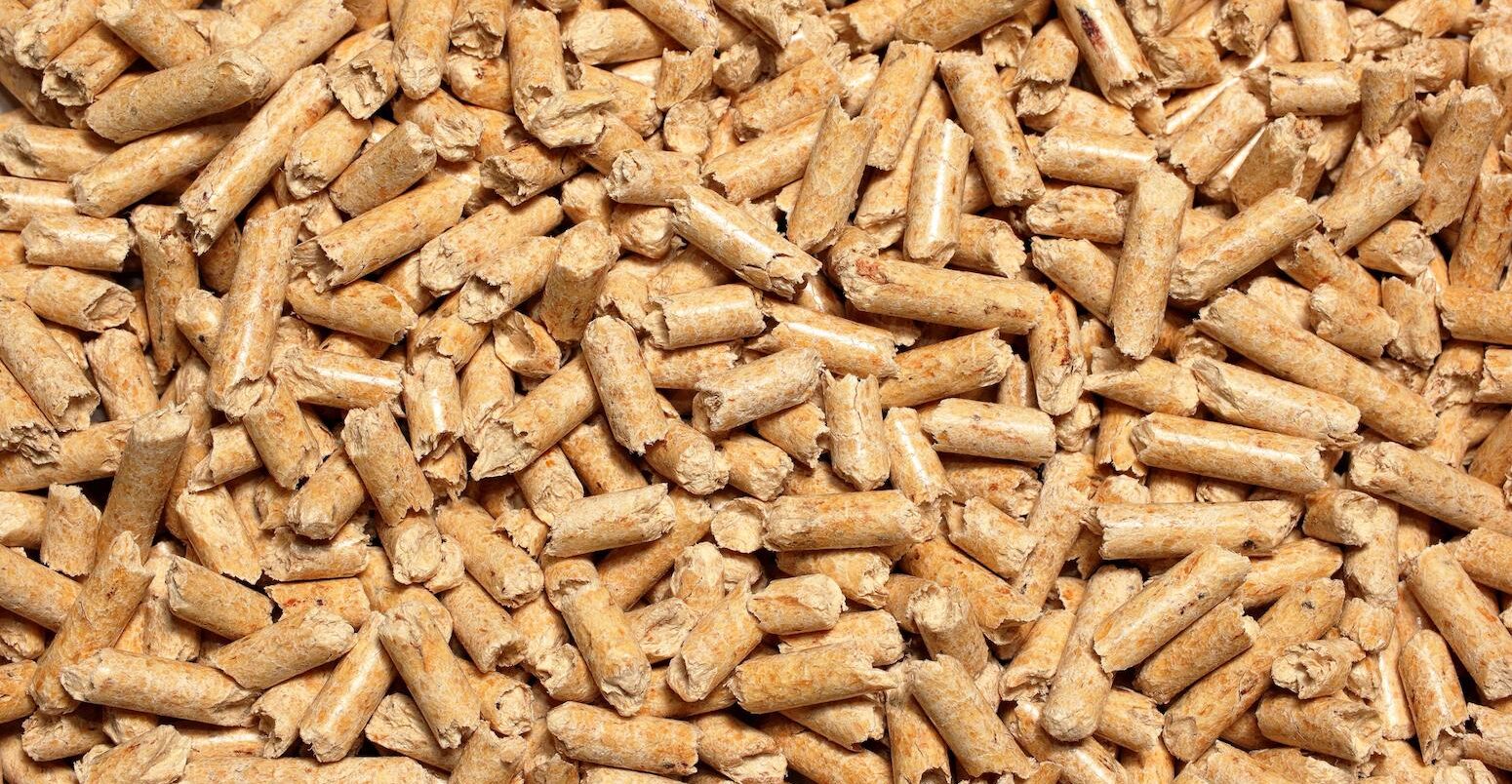
Q&A: What does the UK’s new biomass strategy mean for net-zero?
Molly Lempriere
08.18.23Molly Lempriere
18.08.2023 | 1:01pmLast week, the UK government released its long-awaitedbiomass strategy, which lays out the steps it intends to take to develop a sustainable, well-regulated biomass sector.
The strategy was supported by apublic dialogueon the role of biomass in achieving net-zero, a call for evidence and a report from the “task and finish group” of the Department for Energy Security and Net Zero’s chief scientific adviser.
The 200-page document explores the sustainability of the sector, the priority use cases and the development ofbioenergy with carbon capture and storage(BECCS).
在佛reword, climate change minister Graham Stuart says:
“[Biomass’s] future potential is extraordinary: it is a renewable source that can be used across all three energy sectors (transport; heat; and electricity), as well as non-energy sectors. It can deliver low carbon energy, displace fossil fuel use in materials, and produce negative emissions when combined with carbon capture and storage.”
Biomass – defined within the strategy as any material of biological origin – contributed8.6%of the UK’s energy supply in 2022. It is currently used predominantly for electricity generation, biofuel in vehicles and domestic heating.
The UK produces around65%of its biomass supply, while the rest is imported either as a final fuel or raw or processed feedstock.
The new strategy, built on thebiomass policy statementpublished in November 2021, aims to “set out the role biomass can play in reaching net-zero, what government is doing to enable that objective and where further action is needed”.
- How to ensure a ‘sustainable’ source of biomass?
- Will biomass be sourced domestically?
- Which biomass uses will be prioritised?
- How will biomass be used across the economy?
- Can BECSS achieve negative emissions?
- What are the next steps for a ‘well-regulated’ sector?
How to ensure a ‘sustainable’ source of biomass?
One of the most significant areas of focus within the strategy is the sustainability of biomass – both in terms of how it is cultivated and how it is used.
It sets out a key commitment to consult on, develop and implement a “cross-sectoral common suitability framework”. This is intended to help align sustainability requirements across sectors and create a minimum sustainability criteria that is shared across the bioeconomy, which could expand to cover emerging biomass feedstocks and uses, it states.
Currently, criteria used to define the sustainability of biomass – which is split across the sustainability of land use and the greenhouse gas (GHG) it produces – are set out within pieces of sector-specific legislation, although they contain “broadly similar overarching criteria”, the strategy says.
The main differences between schemes are the amount of indirect land-use change they allow, the GHG thresholds they set, whether there is a cap on certain crops and whether they use waste products.
While much space is given to the discussion of sustainability criteria, the strategy does not include a set definition of “sustainability”.
In developing the biomass strategy, the authors looked at stakeholder engagement, recommendations and insights from expert reviews, as well as reviewing the existing policy landscape.
These multiple sources highlighted inconsistencies in the perception of existing biomass sustainability. Within the 2021call for evidencefor example, 38% of respondents view existing sustainability criteria to be sufficient and robust.
Yet, within thepublic dialogueon biomass – commissioned by the government in collaboration with theUK Research and Innovation’sSciencewise– participants said they were sceptical about the concept of “sustainable biomass”, as well as the feasibility of implementing the current criteria.
This has been affected by high-profile storieshighlighting scandalsassociated with imported biomass, such as allegations byBBC’s Panoramathat Drax was using trees from environmentally-important forests in Canada. The new strategy pledges to improve the regulation of biomass standards, building on updates introduced in 2018.
Dustin Benton, policy director at thinktankGreen Allianceand a member of the “task and finish group” that helped create the strategy, tells Carbon Brief:
“[The current standards are] not good enough, which is why government committed to updating them. Given the UK’s high future reliance on imported bioenergy in the current strategy and recent scandals associated with Drax, it’s prudent to go beyond the 2013 timber regulations.
The2013 timber regulationsare designed to tackle illegal logging and create a demand for legally harvested timber. The regulations highlight that deforestation leads to loss of ecosystems and biodiversity, and therefore illegal logging would be considered at odds with sustainable biomass.
Benton continues:
“More significantly, it’s prudent to consider how we might need fewer negative emissions in the future – the big sources of residual emissions that drive up demand for negative emissions are from agriculture and aviation, and both could be lower than we currently expect with the right innovation strategy.”
The emissions created in the sourcing and production of biomass were viewed by those involved in the public dialogue as “intuitively unsustainable”. The complexity of international supply chains fed into this view, with domestic biomass viewed as more sustainable.
This echoed the view of the CCC, whose2018 reportalso fed into the biomass strategy.Dr Nix Rust,land use, agriculture and nature G6 team leader at the UK’sClimate Change Committee(CCC), tells Carbon Brief:
“Our long-standing position is that we would like to have as much of the bioenergy production done in the UK as possible. This is primarily because of the risk of having it produced abroad without sufficient governance to ensure that it is definitely sustainable.”
The discussion around domestic versus international feedstocks – and its implications for the sustainability of biomass – was also a tenet of areview of sustainability criteriaproduced by the Aston University-basedSupergen Bioenergy Hub, which works across academia, industry, government and societal stakeholders to develop sustainable bioenergy systems. This also fed into the biomass strategy.
The review highlighted inconsistencies in the sustainability criteria depending on how the biomass is used. This makes it harder to make a fair comparison between uses, the review said.
Both domestic and international feedstocks are expected to play a role in the biomass sector out to 2050, the strategy states, but the emphasis must be on areas with the most significant impact on emissions.
Prof Patricia ThornleyatAston University, who worked both on the Supergen report and formed part of the biomass strategy expert group, said in a release:
“It is important that the strategy recognises the potential of imported as well as indigenous biomass in achieving global greenhouse gas reductions. Sustainable systems should grow, convert and use biomass in the locations where they can deliver most impact, ensuring we take account of all supply chain emissions. We shouldn’t shy away from imports where the source is sustainable and the overall system makes environmental, economic and social sense.”
The strategy includes recognising developed sustainability policies in the energy and transport sectors, where policies have developed over years of iterations. But sectors such as chemical, construction and manufacturing sectors – where biomass use is growing in importance – lack similarly stringent requirements, it adds.
The current sustainability criteria are targeted to the needs of each sector, as well as having a level of flexibility that allows it to align with wider environmental and international policies. But there are areas that need to be strengthened, the strategy states.
The proposed overarching sustainability framework would help tackle inconsistencies between sectors, reduce reliance on local governance mechanisms and develop criteria for new and emerging feedstocks and technologies, the strategy says.
The framework – on which the government is planning to consult in 2024 – is slated to include:
- A common GHG emissions calculation methodology.
- Indirect land-use change (ILUC) criteria.
- Practicalities of accounting for soil carbon changes.
- A requirement for biomass users to ensure that 100% of woody biomass feedstocks are proven sustainable (where not already mandatory).
Will biomass be sourced domestically?
With the demand for biomass expected to increase in the medium-to-long term to support net-zero, the sourcing of sustainable fuel for biomass will be of paramount importance, says the strategy.
The potential future availability of sustainable biomass is “uncertain and challenging to determine with precision”, notes the strategy, “as the biomass feedstock supply is so diverse, understanding future availability is a complex task and one which is subject to significant uncertainties”.
Biomass feedstocks can be categorised into perennial energy crops, biogenic (biomass growth that sequesters carbon) wastes and residues (including forestry residues), arable crops and biofuels.
Participants within the biomass public dialogue expressed a clear preference for waste as a source of biomass as they saw it as a more reliable source, with a lower impact on the environment, which does not conflict with other uses of land.
Both domestic and imported supply is expected to continue to play an important role in supporting biomass use, the strategy says.
It explores two supply scenarios that have been developed to minimise impacts of land use and food security. They include limiting global land available for biomass production by only allowing expansion of bioenergy crops for import to the UK to be grown on abandoned arable land, for example.
In these scenarios, the total potential sustainable biomass available to the UK varies between an estimated 550-750 petajoules (PJ) in 2025, and 500-1,000PJ in 2050. Both scenarios show that the availability of domestic feedstocks remains relatively stable, with more significant variation in international sources.
In 2022, 66% of biomass feedstocks used in renewable energy supply in the UK were from domestic sources. Around35%of this was made up of plant biomass such as straw, wood pellets and agricultural residues. Around 121,000 hectares of land are currently used to grow biomass crops for energy in the UK.
Biogenic waste made up around 19% of domestic feedstock supply, including waste wood, sewage gas, landfill gas and food waste. The rest came from anaerobic digestion, and other renewable and non-renewable sources, according to the strategy.
In the transport sector, renewable fuels from UK feedstocks made up about 10% of total renewable fuels in 2021. Of these, 77% were produced from a waste feedstock, such as cooking oil.
| Usage | 所以urce | 千瓦时(TWh) |
|---|---|---|
| Used to generate electricity | 所以lid biomass (plant and animal) | 62.2 |
| Biogas (landfill, sewage and anaerobic digestion) | 21 |
|
| Biodegradable wastes | 19 | |
| Bioliquids | 0.3 | |
| Used to generate heat | 所以lid biomass (wood, waste wood, plant and animal biomass) | 32.7 |
| Biogas (landfill, sewage and anaerobic digestion) | 2.1 | |
| Biodegradable wastes | 1.4 | |
| Bioliquids | 0.5 | |
| Used as transport fuels | Biodiesel | 13.7 |
| Bioethanol | 7.2 | |
| Other fuels (e.g. biomethane, hydrogenated vegetable oil (HVO), sustainable aviation fuel (SAF), drop-in fuels) | 6.4 | |
| Biogas (biomethane) injected into the grid | Anaerobic digestion | 6.2 |
| Sewage gas | 0.6 | |
| Total | 173.5 |
There are a number of core policies that are explored within the strategy that could underpin current and expand domestic biomass supply.
This includes support for perennial energy crops and short-rotation forestry. Currently there is a small area of the UK used for perennial energy crops and a negligible amount dedicated to short rotation coppice. Given biomass ambition, it is likely that the UK will grow more biomass in the future but this must not compromise the government’s commitment to maintaining current levels of food production, the strategy says.
The strategy explores the potential of several specific plants, including miscanthus, unmanaged broadleaf, hemp and others as domestic sources of biomass.
Prof Iain Donnison, head of the institute of biological, environmental and rural sciences atAberystwyth University, commented following the release of the strategy:
“The UK’s Climate Change Committee recommended that approximately 750,000 hectares of perennial biomass crops, such as Short Rotation Coppice (SRC) willow and miscanthus, should be planted in the UK by 2050 and that this could be achieved without any impact on food production. Current planting rates are less than 1,000 hectares per year, so there is clearly much to do.”
In 2022,34%of biomass feedstocks that were used in UK renewable energy production (across heat, electricity and transport) were from international sources. This is composed primarily of plant biomass (such as wood pellets, straw and other plant-based biomass), waste wood, wood and liquid biofuels.
Plant biomass, mostly wood pellets, made up61%of all biomass imports in 2022. In 2021, the majority of imports (around 60%) came from the US, 18% from EU countries and 16% from Canada, with the remaining pellets from Brazil and Russia.
Following Russia’s invasion of Ukraine, it is expected that the UK will have ceased sourcing wood pellets from the country in 2022, the strategy notes.
In the transport sector, imported feedstocks made up90%of total renewable fuels in 2021.
Despite the uncertainty over the long-term market developments of international biomass feedstocks, it is reasonable to expect global bioenergy production will scale-up and diversity over time as countries look to move away from fossil fuels, the strategy says. This will “ultimately lead to a more resilient international biomass feedstock market with greater number of countries supplying feedstocks, which will help reduce future supply risks”, notes the strategy.
Benton tells Carbon Brief:
“[At present], there just isn’t enough biomass to go around. The strategy partly acknowledges this, by pointing out that unless an ambitious level of biomass is available to import, net-zero can’t be met ‘based on current demand and technology assumptions’.
“事实上,英国可以避免需要进口bioenergy if it is willing to change its technology assumptions: our own work shows that the UK could hit net-zero while only using UK waste-derived biomass if alternative proteins are scaled up. Other options for not needing bioenergy imports include hydrogen or e-fuelled aviation, or the sorts of low energy futures that were explored by theCentre for Research into Energy Demand Solutionsacademic consortium.
“The biomass strategy didn’t grapple with these bigger questions, but it did at least start to direct bioenergy to better uses – it’s the minimum that the policy document could do.”
The strategy outlines a number of potential areas for innovation within biomass feedstocks in the UK, driven by the government’sbiomass feedstocks innovation programme.这授予£36 m跨两个阶段:一个设计and feasibility stage that ran from July 2021 to March 2022 awarding £4m in funding, and then £32m in funding to take projects through to demonstration.
In total, the programme awarded 12 contracts with projects set to conclude in March 2025.
Projects in the second stage of the programme highlighted the uncertainty around the end use of biomass crops as a key challenge, given they are long-term commitments with many markets around different technologies and sectors still emerging. As such, “policy is vital”, the strategy notes.
Which biomass uses will be prioritised?
The biomass strategy shifts the government’s outlook closer to that of theCCC’s 2018 report, putting an emphasis on prioritising the areas in which biomass is used.
“The use of sustainable biomass must be prioritised in sectors that offer the greatest opportunity to reduce emissions and where there are fewest options to decarbonise through alternative low carbon technologies,” notes the strategy.
战略的生物量的“优先使用”原则ss address four main areas: sustainability, air quality, net-zero, and the circular economy and resource efficiency.
Implementation of these principles should also take into consideration the wider context for biomass across the UK economy, notes the strategy. This includes energy security – particularly in light of theenergy security planset out in March 2023 – as well as land use and sector-specific objectives.
The strategy sets out expectations for the short-, medium- and long-term, taking into account the priority areas it could have the most significant impact.
In the short-term, biomass will continue to make “important contributions” across the economy to support decarbonisation through existing support schemes. But biomass should avoid technology “lock-in” so as to not impact the UK’s ability to meet carbon budgets and net-zero later on.
Medium-term priorities for biomass are mostly focused on the need to meet thesixth carbon budget. This will be particularly key for hard to decarbonise sectors such as industry and aviation, the strategy says.
The strategy projects that average annual biomass demand between 2033 and 2037 will be 176TWh per year. This represents little overall change from biomass demand in 2022, although the makeup and use is expected to shift.
This level of demand is estimated to be within the range of total potential biomass availability, which is between 130TWh and 251TWh in 2035.
The long-term priorities focus on whole-energy system analysis, using theUK TIMES modelto identify the most cost-effective way of achieving net-zero while meeting energy demands. It is important to remain flexible to allow the biomass sector to react to ongoing developments, the strategy says.
The strategy runs through three scenarios; high electrification, high resource and high innovation.
Overall, these show that biomass uses that produce negative emissions through BECCS should be prioritised, with power BECCS likely to provide an important contribution to deliver negative emissions and low-carbon energy.
BECCS could also play a long-term role in the form of hydrogen BECCS, biokerosene BECCS forsustainable aviation fuel, and powering industrial processes. However, the exact amount and role of these should be determined over time as cost- and carbon-effective solutions develop, the strategy says.
This will include the development of carbon transport and storage infrastructure, required for BECCS technologies to deliver negative emissions.
Drax recently announced it wasdelayinga “flagship” BECCS project by three years, pointing to the uncertainty around a 120km pipeline to the North Sea, which is required to transport and store the carbon.
How will biomass be used across the economy?
The biomass strategy details the potential use of biomass across a number of key sectors, including electricity, biomethane and greening the gas grid, heating, transport, industry, hydrogen and non-energy uses.
BECCS will form the core role of biomass in the decarbonisation of the electricity sector, the strategy says, providing either baseload or dispatchable power. The exact role of BECCS will be further reviewed as part of the government’sreview of electricity market arrangements(REMA), the second consultation of which is due in Autumn 2023.
Biomethane is generally produced throughanaerobic digestion, and can be injected into the existing gas grid to directly displace fossil methane gas across a range of end uses. This is considered a cost-effective way to lower carbon emissions in the near term, helping the UK hit its carbon budgets.
As a result, the strategy says this should be one of the priority uses of biomass, given the flexibility of biomethane use.
For anaerobic digestion, the government is developing proposals on reducing ammonia emissions from organic manures, as the toxic substance can be leaked if digestate is not properly managed. These will be consulted on later this year.
The use of biomass in heating has increased in recent years, with biomass for heat totalling 3.2m tonnes of oil equivalent (Mtoe) in 2022, or 72% of the 4.4Mtoe of heat from renewable sources (the majority of the remainder came from heat pumps). Of this, 2.8Mtoe or 89% was provided by wood, waste wood and plant biomass.
Currently, electrification of heat is one of the few proven, scalable options for decarbonising heat, and the government’s10-point plan for a green industrial revolutionincluded a target of installing 600,000 heat pumps a year by 2028.
“生物的作用等同于某些properties, such as off-gas-grid homes that are not readily suitable for heat pumps, and where appropriate mitigations can be set in place to minimise air quality impacts,” the biomass strategy states.
Given the niche role it will play, biomass for heating has received government support previously through thedomestic renewable heat incentive scheme– which closed in 2022 – thenon-domestic renewable heat incentivescheme and theboiler upgrade scheme.
There is also some potential for biomass to play a role in decarbonisingcombined heat and power(CHP) systems, the strategy says.
On biomass boilers, the strategy notes that there must be a consideration of the local impacts, given its potential for air pollutants – in particular from domestic or district biomass boilers. These can disproportionately impact people’s health, given their closer proximity to human populations, as domestic biomass boilers have less stringent emission limits than those for industry, the strategy notes.
The strategy specifies, however, that the government is not considering a ban on domestic burning in England as it recognises that some households are reliant on solid fuel burning as their primary source for heating, hot water and cooking. This consideration is particularly pertinent in light of the current focus on energy security andhigh energy prices.
Biomass already plays a role in the decarbonisation of the transport sector, with bioethanol, biodiesel and biomethane expected to account for around a third of the carbon savings in the domestic transport sector required under the current, fourthcarbon budget.
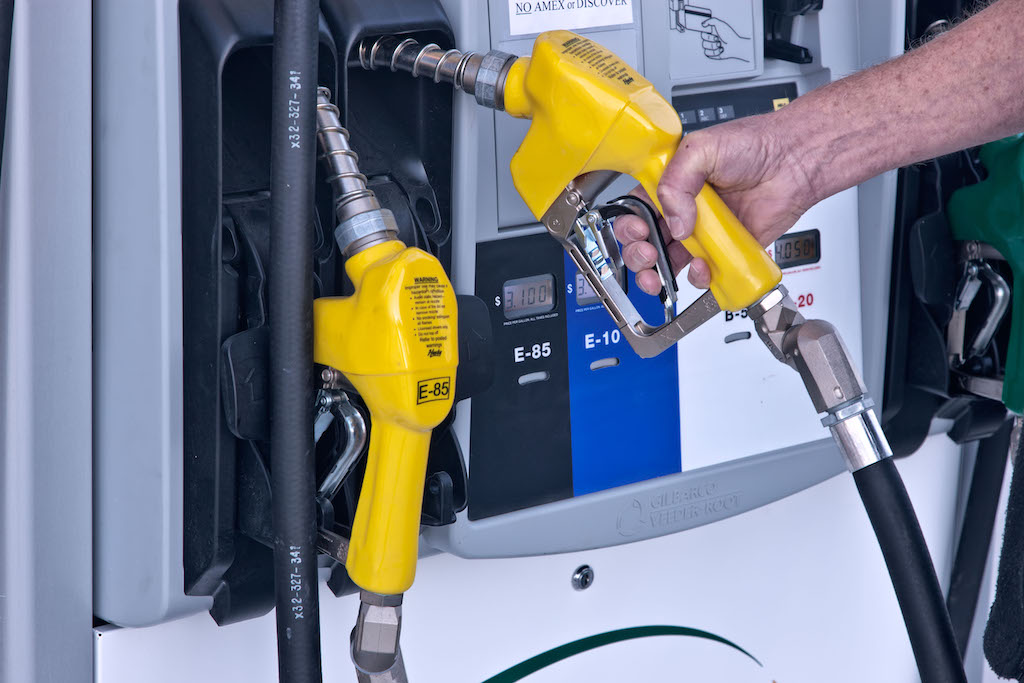
Biofuels can be made from a range of feedstocks, but as of 2021, 55% came from used cooking oils. Most biofuel is deployed in the transport sector to reduce road vehicle emissions, where 5.4% of total fuels supplied to the road and non-road transport sectors come from biofuels, according to the strategy. However, there is also scope to support wider decarbonisation including developing so-called “sustainable aviation fuels”。
As with energy, biomass will likely play a role in the decarbonisation of industry through BECCS. Biomass has already increased steadily from 2 terawatt hours (TWh) in 2005 to 20TWh in 2022, within industry, and is expected to continue to grow.
The strategy suggests biomass use in industry should be prioritised, in a combination with carbon capture usage and storage (CCUS). While there are already regulatory requirements across the industrial and commercial biomass sectors, action is needed to address gaps, the strategy says. It points to the government’sclean air strategy, which has already discussed the case for tighter emissions standards.
Additionally, BECCS technologies could help manage air pollution, as CCS providesadditional benefitsfor reducing certain pollutants such as sulphur dioxide, the strategy says.
The hydrogen economy is still nascent, with little expected to be generated by biomass – whereby biomass gasification along with CCS are used to produce hydrogen – this decade.
However, as set out in the government’snet-zero strategy, BECCS could be providing 20% of the UK’s hydrogen supply by 2050. Although, this will be contingent on the availability of appropriate biomass feedstocks, the availability of CCUS infrastructure and technological innovation.
Can BECSS achieve negative emissions?
Greenhouse gas removal (GGR) technologies, including engineered removals such as biomass energy with carbon, capture and storage (BECSS), will be essential to meeting net-zero in the UK, the strategy states.
“Well-regulated BECCS can provide both genuine GGRs and low-carbon energy or products,” it notes.
As outlined in the government’s net-zero strategy in 2021, engineered removals could be scaled to 75m tonnes of CO2 per year (MtCO2/yr) and 81MtCO2/yr by 2050. The strategy set an ambition of at least 5MtCO2/yr of engineered removals by 2030, the majority of which is expected to come from BECSS.
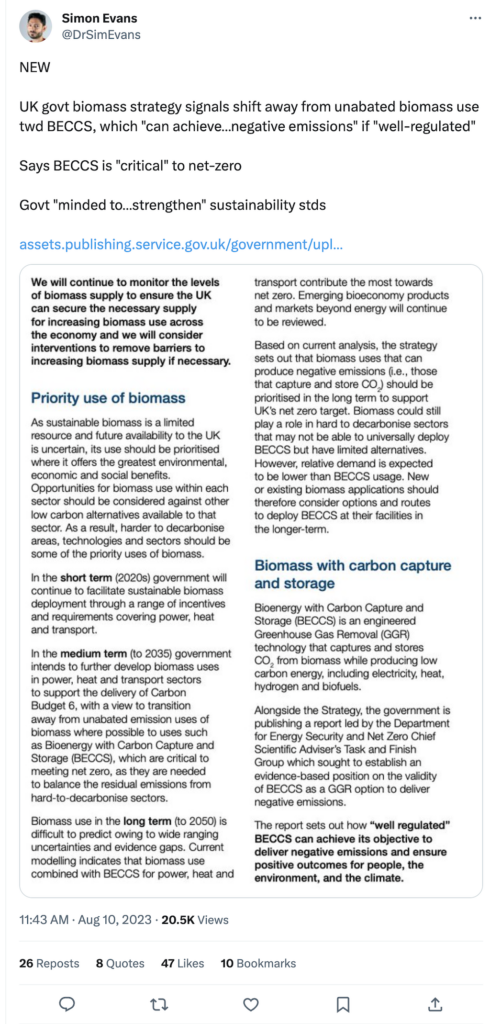
The strategy highlights that public perceptions of BECCS focus on its validity as a negative emissions technology, as well as scepticism over the ability to deploy BECCS at scale.
This is a particular reason why much of the biomass strategy focuses on sustainability.
The strategy states that carbon capture projects have been operating in locationsaround the worldsince the1970s, although most have been at a small scale.
BECCS itself is not currently used at scale in the UK, although it is operating both at demonstration plans and at commercial scale in some parts of the world. According to a 2022 Global CCS Institutestatus report, there are 30 commercial CCS facilities in operation, 11 under construction and more than 150 at various stages of development.

The potential of BECCS to achieve negative emissions was a core focus of the task and finish groupreport, which was released alongside the biomass strategy.
No “insurmountable scientific barriers to the net removal of CO2 from the atmosphere and subsequent permanent geological storage via BECCS” were identified by the group, although numerous challenges were highlighted.
The strategy recognises that negative impacts of forest carbon stocks and supply chain emissions could reduce the efficacy of BECCS. After accounting for supply chain emissions and losses of carbon that is not captured by living matter, the carbon removal efficiency of power BECCS could be between 65-85%, the strategy says.
It reaffirms the government’s position that the GGRs are not a substitute for taking “decisive action across the economy to cut emissions”. The report also identifies “substantial opportunity for the UK to develop a leadership position on the delivery of sustainable BECCS and GGRs”.
The biomass strategy set out four key principles for the development of BECCS. First, that the government should only support the capture and storage of biogenic CO2 emissions generated from sustainable biomass that meets “clear, enforceable and transparent sustainability criteria”.
Second, that support should only be given to BECCS systems that deliver net GGRs based on full life-cycle assessments, irrespective of where in the supply chain emissions occur.
Next, BECCS should provide valuable, low carbon co-products or services alongside GGRs to maximise the use of sustainable biomass.
Finally, a BECCS project must achieve long term and safe carbon storage to guarantee atmospheric carbon removal.
“Unlike targets and rules, this principles-based system is flexible enough to remain valid in the face of evolving evidence and technological development and innovation,” the strategy notes.
There is already active support for BECCS in the UK, including a commitment to deploy CCUS in two industrial clusters by the mid-2020s as set out in the government’s “Powering Up Britain” package of measures. The net-zero strategy further confirmed the government’s ambition to capture and store 20-30MtCO2/yr by 2030, with at least 10Mt of this capacity to be delivered through the second track of the clusters.
The strategy recognises that delivering BECCS will likely require government support initially, therefore a number of business models are being developed to support BECCS or facilitate the generation of negative emissions, it notes. This includes a dualContract for Difference– the government’s main subsidy scheme for renewable energy – for BECCS and a contract-based business model for the wider GGR sector.
As noted in the previous section, there is potential for BECCS to play a role in the decarbonisation and development of industry, waste, biomethane, hydrogen and other low carbon fuels including sustainable aviation fuels, the strategy says.
Ruth Herbert,CEO of theCarbon Capture and Storage Association(CCSA) said in a press release:
“BECCS is one part of the suite of carbon capture and storage solutions that has the potential to underpin the next industrial revolution. We urgently need HM Treasury to set out further detail on the scale and timing of support to BECCS and other potential carbon capture sites.
“Failure to act this autumn would risk undermining investor confidence in the UK while others such as the US race ahead in the development of this vital technology.”
What are the next steps for a ‘well-regulated’ sector?
Throughout the biomass strategy, there is a focus on developing a “well-regulated” sector.
Currently, the lack of overall governance leaves scope for essential elements to fall through the cracks, as does the different definitions of sustainability within different sectors, which could ultimately damage the role biomass plays in reaching net-zero.
Dr Rust tells Carbon Brief:
“Something suggested in the strategy is to have a governing body that oversees all of this because, at the moment, it’s not properly coordinated. This could really help with ensuring consistent governance across the sector and for different biomass end uses.”
The task and finish group suggests that BECCS could achieve its objective to deliver negative emissions and promote positive outcomes for people, the environment and the climate, but only if biomass is well regulated.
This means it must be sourced sustainably with appropriate certification, that significant negative impacts on forest carbon stocks are avoided, and carbon and supply chain GHG emissions are minimised and regulated, the group says. The BECCS value chain must also be robust and independently verified.
“These areas are all being addressed in government policy development currently,” the group says.
This was echoed by Benton, who tells Carbon Brief:
“There are three major components: first, policy should clearly exclude BECCS projects that aren’t carbon negative across their whole footprint, which in practice means only residues, thinnings, and similar and would require very high efficiency capture at the plant. Proving this is challenging but possible to do and it clearly is not being done currently.
“Second, this needs to be measured against a counterfactual of what the forest landscape would have done otherwise: many forests would continue to sequester carbon if they weren’t felled. Again, this is possible to model and measure, but isn’t being done.
“Finally, regulation, particularly of imported products, has proved to be difficult to track and enforce, but could be done with the right agreements and auditing. It is scientifically possible for a carbon negative BECCS to exist, but it would need a step change in how it is regulated.”
The biomass strategy takes steps to address the issues currently with the sector, providing greater clarity of the direction of development. However, many elements now rest on the development of technologies, incoming consultations and tighter regulations.


